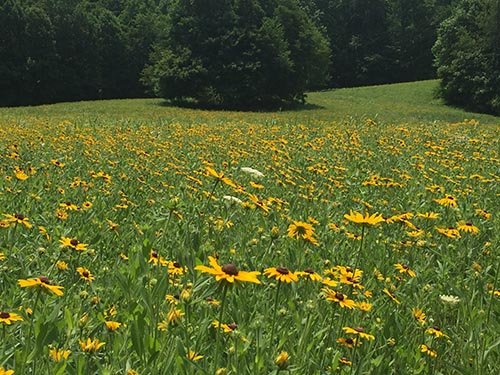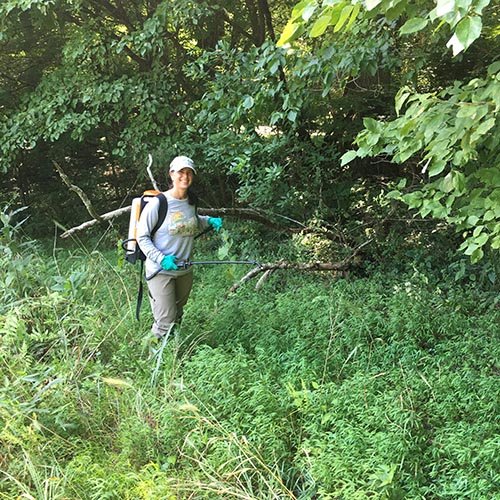It can be hard to imagine over 3.5 million acres of grasslands stretching in a horseshoe shape from what is now the Land Between the Lakes area of Kentucky and Tennessee east to the Mammoth Cave area of Kentucky. Yet, much of that area was once a mixture of tallgrass prairie, oak savannas, and depressional wet meadows. We know this from a combination of historical records and by looking at the types of plants and animals that can be found there.
Take for example, Dunbar Cave State Park which is located in Clarksville, Tennessee. Historical land grant records from the Revolutionary War show that this area was an oak savanna in the 1780s. Other records show that many of the local roads follow historic bison trails, which means that cars travel down the same basic paths today that bison traversed a couple hundred years ago.
Over the past several years, Dunbar Cave State Park, Friends of Dunbar Cave, Roundstone Native Seed, and the Southeastern Grasslands Initiative have worked together to bring back a small portion of the once vast grasslands that historically would have been found here. The Dunbar Cave Grassland is open to the public and available to anyone who wants to visit.
Dunbar Cave Grasslands is located at Dunbar Cave State Park in Clarksville, Tennessee and offers a small glimpse of the vast grasslands that historically were found in the area.
The Story of a Prairie Recreation
In 2014, the Friends of Dunbar Cave acquired 30 acres of land adjacent to Dunbar Cave State Park. Approximately half of that land was a hayfield, and had been a hayfield for over 100 years. Conversations between Dunbar Cave State Park, Friends of Dunbar Cave, Roundstone Native Seed, and the Southeastern Grasslands Initiative led to the decision to return this hayfield to a tall grass prairie, representative of what historically would have been there.
Monarch butterflies and many other grassland-dependent animals have been documented at Dunbar Cave Grassland.
Roundstone Native Seed donated all of the herbicide to prepare the site for planting, labor, and seeds to install the grassland. A heavy infestation of fescue and Johnson grass meant that planting had to be delayed while multiple herbicide treatments were applied to the non-native grasses to get them under control. Without this meticulous pre-planting site preparation, the Johnson grass and fescue would have overtaken and crowded out any newly planted seeds.
In 2017, the site was planted with a mixture of native wildflowers and grasses. All of the seeds were local ecotype seeds that came from the Pennyroyal Plain region or immediately surrounding regions. Over the next couple of years, seeds from additional species were gathered from nearby areas and scattered throughout the grassland to increase the plant biodiversity. Several additional species, such as slender ladies-tresses orchid (Spiranthes lacera) and deertongue panic grass (Dichanthelium clandestinum), came back naturally from the original seedbank and rootstocks that were still in the soil.
Restoration work and maintenance at Dunbar Cave Grassland is ongoing.
Volunteers are vital to the ongoing restoration and management activities at Dunbar Cave Grassland. Contact the Southeastern Grasslands Initiative to find out how you can help.
Visit Dunbar Cave Grassland
Dunbar Cave Grassland is located on the north side of Dunbar Cave State Park in Clarksville, Tennessee. The 0.75-mile Grassland Trail wanders through the grassland. Dunbar Cave State Park is open year-round from sunrise to sunset.
Over 175 species of native plants have been documented in the 15-acre Dunbar Cave Grassland. New species of plants, as well as other organisms, continue to be documented each year. Everyone is invited to help survey and document the plants, animals, and fungi of Dunbar Cave Grassland by submitting your observations to the Dunbar Cave Grasslands iNaturalist project.
The Southeastern Grasslands Initiative hosts regular volunteer days throughout the growing season to nurture and maintain the Dunbar Cave Grassland. If you are interested in volunteering, please sign up to receive monthly emails about upcoming volunteer opportunities.
SHANNON TRIMBOLI, INTERIM DIRECTOR OF COMMUNICATIONS
Shannon helps the Southeastern Grasslands Initiative tell the forgotten and untold stories of our Southeastern grasslands.




